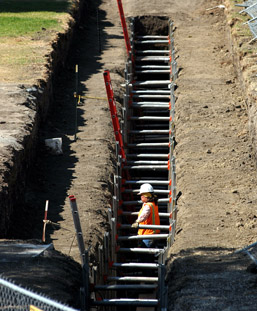Proposed site for new courthouse has at least one active
fault
The discovery of an earthquake fault running through the old
Fremont School property could force state officials to choose an
out-of-town location for a new county courthouse.
A full-scale geologic investigation is now under way to
determine if property at the corner of Fourth and West streets is
seismically safe enough to build on.
Proposed site for new courthouse has at least one active fault
The discovery of an earthquake fault running through the old Fremont School property could force state officials to choose an out-of-town location for a new county courthouse.
A full-scale geologic investigation is now under way to determine if property at the corner of Fourth and West streets is seismically safe enough to build on.
“We’re digging it up and looking for any fault hazards,” Hollister City Manager Clint Quilter said. “We are looking particularly for fault lines and discontinuity in the ground.”
So far, the month-long investigation has revealed at least one fault within the first trench dug by the crew from William Lettis and Associates of Walnut Creek. However, Quilter said it is far too early in the study to know how the discovery of this fault will affect the courthouse project.
“Until the digging is completely done, and a full report has been made, we won’t know the implications of what this single fault could mean,” he said. “No decisions can be made based on that single finding.”
Constructing a new courthouse in San Benito County has been considered a priority by state officials since California began a court construction funding program in 2006. The superior court now in use was built in 1962 and is considered outdated, cramped and lacking in modern security measures.
Estimated cost of the new courthouse is $32.5 million; however if an adequate site is not found by June 30, 2009, funding could be withheld by the state. Originally, the Judicial Council of California said it would begin pursuing two courthouse sites – the old Fremont School site and its first choice, an area on Flynn Road location next to the county jail.
Although a committee of local officials commissioned by the state recommended the Fremont School site, the need for a seismic study on that site pushed the council to opt for the Flynn Road site instead.
However, a public outcry over the possible move of the courthouse from the downtown area to Flynn Road prompted the Hollister City Council to fund the seismic study. The approximate $250,000 cost will be picked up by Hollister’s Redevelopment Agency. The city, which owns the Fremont School location, will also donate the land if the site is approved.
“In order for the court system to consider this site, the investigation needed to be done and the other agencies weren’t interested in doing it,” Quilter said. “But there was a big outpouring from the public and a lot of interest in putting the new courthouse on this site, so the city council decided to do it.”
The investigation is expected to be completed sometime next week, Quilter said. It covers a number of areas, including both actual and probable ground motion analyses, evaluation of fault activity, assessments of maximum probable earthquake magnitudes, evaluation of quake recurrence, identification of potential seismic sources and researching both the surface and near-surface geology of the site.
Determining if a potential construction site is located on or near an active fault is required under the Alquist-Priolo Earthquake Fault Zoning Act. Passed in 1972, the act’s main purpose is to prevent construction of buildings used by humans on the surface of active faults. Although there are already buildings on the Fourth Street property, the study is necessary because extensive remodeling is planned for the existing structures.
Faults are fractures in the earth’s crust along which rocks on one side have moved separately from those on the side; a fault trace, which is what the crew from William Lettis and Associates is searching for, is the line on the earth’s surface defining the fault. An active fault, as defined by the act, is one which has ruptured in the last 11,000 years.
San Benito County lies within the regulatory zones of the Alquist-Priolo act, meaning all city, county and state agencies must use fault maps supplied by the California Geological Survey when planning new or renovated construction. If an active fault is found during a geologic investigation such as the one now under way at the old Fremont School property, the law prohibits any buildings in which people will be from being placed over the fault trace and requires the building to be set back at least 50 feet from the trace.
The project also falls under the guidelines of the Seismic Hazards Mapping Act of 1990, which addresses non-surface fault rupture earthquake hazards such as liquefaction (an occurrence in which the strength and stiffness of a soil is reduced by earthquake shaking) and seismically induced landslides.
Quilter said a type of “open house” will be held sometime next week for selected members of the community to view the trenches and learn more about what the investigation has revealed.
“People are very interested in what’s happening out there,” he said.










